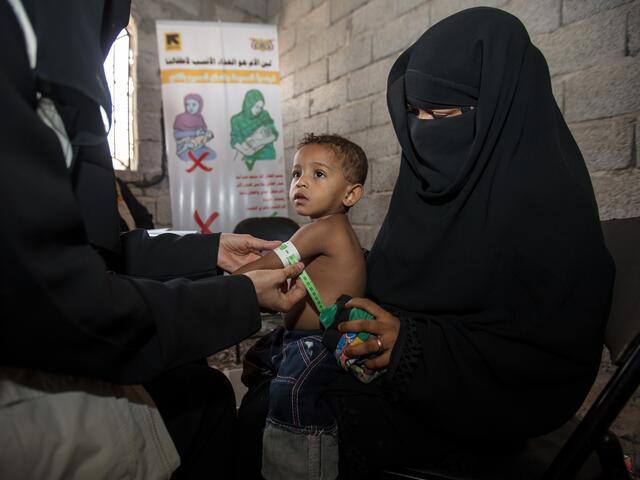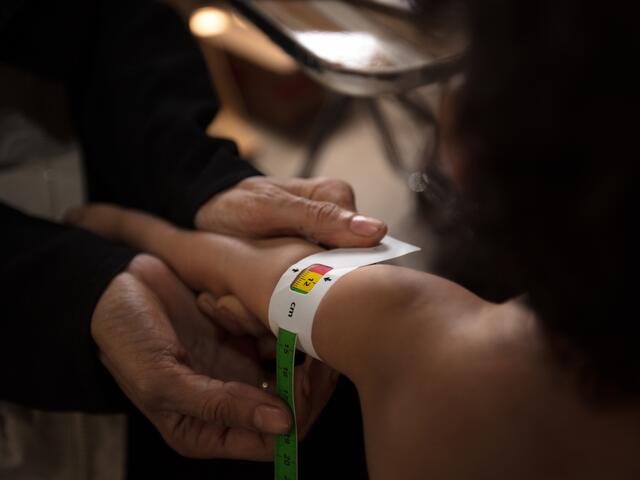
Crisis in Yemen: Unrelenting conflict and risk of famine
Here are five reasons the International Rescue Committee’s Emergency Watchlist ranks Yemen as the country most at risk of humanitarian catastrophe in 2021.

Here are five reasons the International Rescue Committee’s Emergency Watchlist ranks Yemen as the country most at risk of humanitarian catastrophe in 2021.
Yemen tops the International Rescue Committee's annual Emergency Watchlist for the third year in a row: a consequence of over five years of war and severe underfunding that has pushed the country to new lows in 2020. Here's what you need to know about what is still the world’s largest humanitarian emergency.
In 2015 a Saudi and Emirati-led coalition intervened in Yemen to support the Internationally Recognized Government against the Ansar Allah movement. Five years later, the conflict remains intense and the humanitarian response is on the brink of collapse.
Conflict between forces loyal to the government and Ansar Allah have escalated in Jawf and Marib governorates throughout 2020. Despite localized agreements over the past two years, there is no sign of a political resolution to the crisis. Meanwhile, the COVID-19 pandemic and a steep drop in humanitarian funding put the country at risk of massive further deterioration. People are increasingly struggling to get enough food and the World Food Program has warned that Yemen could face famine in 2021.
At the end of 2020, malnutrition for children under 5 was the highest ever recorded, yet ... the world has turned its back on Yemen.
“Yemen faces a triple threat from conflict, hunger and a collapsing international response," says Abeer Fowzi, the IRC's deputy nutrition coordinator. "At the end of 2020, malnutrition for children under 5 was the highest ever recorded, yet, in the face of an unprecedented threat, the world has turned its back on Yemen."
"Never before have Yemenis faced so little support from the international community—or so many simultaneous challenges,” says Fowzi. Here are five reasons Yemen is the country most at risk of humanitarian catastrophe in 2021, for the third year in a row:
The December 2018 Stockholm agreement between the government and Ansar Allah remains largely unobserved, although there has been some progress on prisoner exchanges. The conflict escalated near the end of 2020, as Ansar Allah forces advanced toward government-controlled oil-producing areas in Marib governorate to the east of Sanaa, Yemen's largest city. Marib hosts one million people displaced from other parts of the country by violence.

Yemen’s ever-deepening economic crisis and fuel shortages mean that the Marib oil fields may be a particular focus for conflict in 2021. At least 90,000 people have been displaced in Marib during 2020 and these numbers will rise if fighting spreads to more densely populated areas. Persistent tensions in southern Yemen between the government and fighters aligned with the Southern Transitional Council also spark sporadic fighting that threatens the lives and livelihoods of Yemenis.
The war has destroyed many Yemenis’ livelihoods, leaving over 80% of the population reliant on humanitarian assistance. The rial, the currency of Yemen, has lost 25% of its value in 2020 alone while rising fuel prices and shortages drive up the cost of food and hinder aid. With the COVID-19 pandemic further restricting people's ability to earn a living, the World Food Program has warned that many Yemenis could be on the brink of famine in 2021. Nearly 17,000 people are already facing famine-like conditions and this could increase to up to 47,000 by June.
Women and girls are likely to be disproportionately affected, given Yemen scores worst in the world for women’s wellbeing. One million pregnant women are malnourished, and 120,000 women and girls are at risk of violence.

The Yemen Data Project found that 40% of deaths in airstrikes since 2015 have occurred in residential areas. This means that Yemenis are more likely to be killed in their homes than any other location. Homes, hospitals, bridges and other critical civilian infrastructure are regularly damaged or destroyed by fighting; only half of Yemen’s medical facilities are still fully functional. The harm facing Yemeni civilians consequently will worsen as the conflict drags on and international attention starts to fade.
The Yemen conflict’s wider impacts are even more deadly and have long-term implications for the country’s recovery. The majority of deaths in the conflict are due to indirect impacts of conflict, particularly reduced access health services, food and infrastructure, according to research by the United Nations Development Program.
Slow approval processes for lifesaving aid programs, and other bureaucratic measures imposed by all parties to the conflict, threaten the humanitarian response. In addition, humanitarian funding has dropped significantly in 2020, forcing 31 out of 41 major United Nations programs to scale back or close down entirely, and the World Food Program to halve food rations for 8.5 million people. As a result, 3 million fewer Yemenis were receiving aid each month by late 2020 compared to the response at the beginning of the year. The IRC and other responders are profoundly concerned about whether there will be enough money to pay for critical humanitarian programs in 2021.

We continue to call on world leaders to meet the growing needs in Yemen by committing to achieving the humanitarian response plan target, which is still only half-funded, and providing an essential rescue package to support Yemen’s collapsing economy.
The Safer, an oil tanker anchored near Yemen’s largest port, Hodeidah, is currently being used as an export terminal. Years of poor maintenance mean it could cause an oil spill four times larger than the 1989 Exxon Valdez disaster, resulting in long-term disruption to the port and the fishing industry, as well as incalculable environmental damage. The port of Hodeidah handles about 70% of Yemen’s commercial and humanitarian imports—so a leak could cause food prices in Yemen to double and fuel prices to triple.
For citations, additional insights on the crisis in Yemen in 2021, and the IRC’s recommendations for the international response, please refer to the full 2021 Emergency Watchlist report.
We also provide clean water and reproductive health care services, deploy mobile health teams to remote areas, and run therapeutic feeding programs for malnourished children. In addition, we provide emergency cash and livelihood programs, services for women and children who have experienced violence, and education for children who are unable to attend school because of the conflict and COVID-19. The IRC is also supporting the establishment of a COVID-19 isolation unit.
Learn more about the IRC’s response in Yemen.
The annual Emergency Watchlist is a global list of humanitarian crises the IRC expects to significantly deteriorate over the course of the coming year. Read about the top 10 crisis countries in the list and download the 2021 Emergency Watchlist report.
Yemenis face an uncertain 2022 as the conflict-driven economic collapse deepens despite a relative lull in fighting. Yemen drops from the top of the Watchlist for the first time in three years not because of an improvement in the humanitarian situation but because crises in other countries are worsening even more rapidly. Read more about the the growing humanitarian crisis in Yemen in 2022.